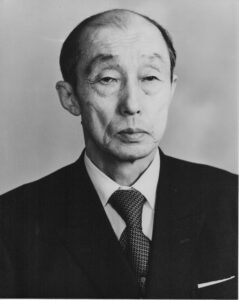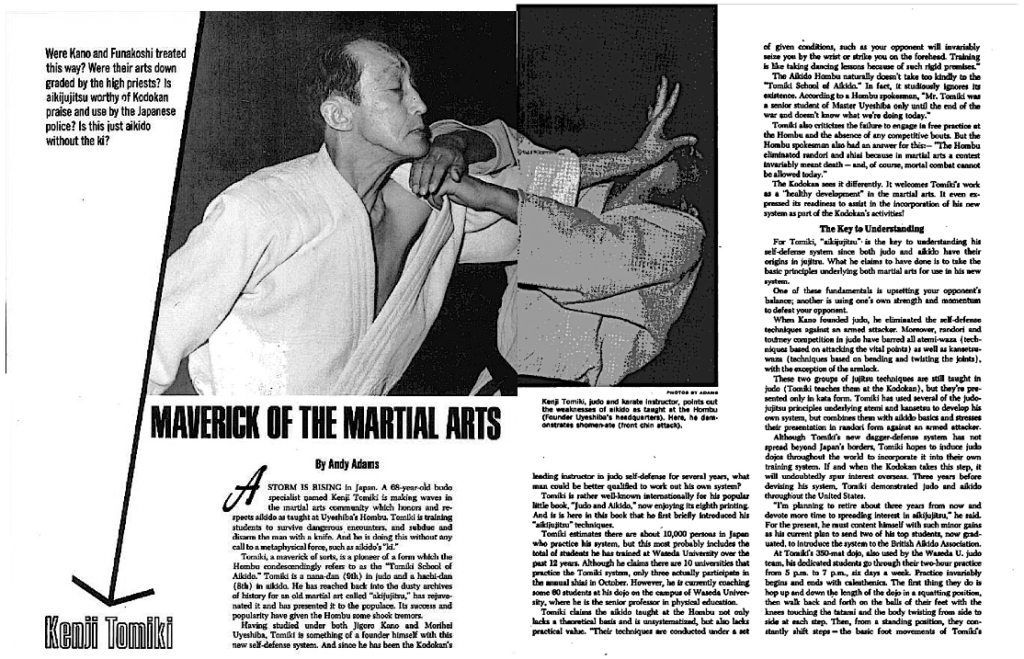
Kenji Tomiki
Founder of Tomiki Aikido
(1900-1979)
8th Dan in Kodokan Judo
8th Dan in Aikido
Direct student of
Jigoro Kano and Morihei Ueshiba
From Tomiki Sensei to the TAA
Kenji Tomiki was born on the 15th of March, 1900 in Akita Prefecture. At the age of six years, he began studying kendo. He began studying judo at the age of ten, and while attending Waseda University in Tokyo, he became the captain of the Judo team. After, he became an uchi-deshi (live-in student) of Jigoro Kano, the founder of Judo. At Kano Sensei’s urging, Tomiki began studying aikijujutsu (as it was then called) with Morihei Ueshiba, known to aikido practitioners as O-Sensei or “great teacher.” Tomiki studied with Ueshiba from 1926 until sometime in the 1930’s, becoming the first student to receive a Menkyo Kaiden, the much sought after teaching credential of the promotion systems of old style Japanese martial arts, roughly equivalent to an 8th degree black belt.
As part of the Japanese education system, Tomiki became a professor at Kengoku University, in occupied Manchuria. Although he was teaching Japanese calligraphy to the Manchurian students, he also volunteered as the university’s judo instructor, and he required his students to also study aikido. He was captured by the Soviets and was held as a prisoner of war, where he developed many of the solo forms used in his style.
After being released, Tomiki worked with the US occupying forces in Japan and then eventually received a professorship at his alma mater, Waseda University. He formed an aikido club there, and during the 50’s and 60’s developed a unique form of aikido which diverged from the style taught at the hombu, or main dojo. He emphasized a competitive element, adopted from judo, which then guided his curriculum design.

Tomiki Sensei died in 1979, leaving behind a diverse and flourishing tradition of competitive or sport aikido. Out of Tomiki Sensei’s teaching came the Japan Aikido Association (JAA) and the Shodokan Aikido Federation (SAF). There are also national organizations in the United States, the United Kingdom, Ireland, Switzerland, Belgium, Russia, Ukraine, Georgia, Australia, and many other countries. These join in competition on the international stage through the Worldwide Sport Aikido Federation (WSAF) and the International Tomiki Aikido Federation (ITAF).
Tomiki Sensei never shied from teaching qualified gaijin or foreigners, and several of his students set up dojo in the United States. In 1990, these dojo were united into what was then the Japan Aikido Association USA (JAA-USA). At the time of founding, these senior instructors all had studied with Tomiki Sensei. Robert Dziubla, one of the founders of the TAA, had traveled to Japan to study under Tomiki Sensei. Among his other accomplishments, Dziubla Shihan led the first American team to win a Japanese aikido randori tournament, and he was the first gaijin to receive his fifth dan under the current testing requirements. In 2012, the JAA-USA was renamed Tomiki Aikido of the Americas (TAA) to reflect a focus on the growth of Tomiki Aikido throughout the continents of North and South America. Until 2022, Dziubla Sensei had served as president of the TAA.
Who is the TAA?
The TAA is a non-profit organization which “seeks to introduce and promote the Japanese martial art of Aikido by organizing training camps, exhibitions and tournaments around the world.”
The TAA brings together Aikido clubs throughout the Americas, including Brazil, the United States of America, and Trinidad/Tobago, with publications, newsletters, seminars, and competitions. The TAA also coordinates various aikido activities with other national and international aikido organizations.
The TAA functions on a non-exclusive and non-discriminatory basis as an umbrella organization for all of the Tomiki Aikido clubs and schools in the Americas that wish to join. As Tomiki Sensei emphasized so many times, we should strive to welcome everyone and to learn from each other by practicing together. To help attain this goal, Tomiki Sensei advocated joint practice sessions as well as open tournaments comprised of both kata embukai and team and individual shiai (randori).
In furtherance of Tomiki Sensei’s desires and goals, the TAA helps to coordinate national and international events, provides support for regional events, encourages the interchange of information on training methods and the coordination of our grading and promotion standards on a national and international level, raises public funds to support the Association and its educational goals, and engages in related activities. Because each of us has a different way of practicing Aikido based on our experiences, body type, and training (and it is this difference that can help to make Tomiki Aikido a strong and vibrant martial art), the TAA does not set binding guidelines on how individual clubs and schools are run. Rather, those are decisions that should be made by the individual sensei who runs the dojo.
The TAA functions as a central coordinating and support center rather than as an authoritarian governor. We strive to unify our teaching methods and promotion standards so that the members of all of our clubs can practice and compete effectively and safely together with members of other clubs, while retaining as much as possible each club’s individuality.